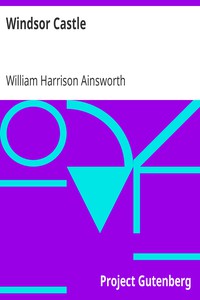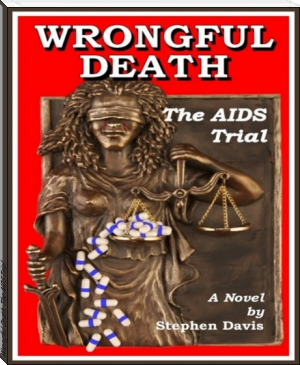Windsor Castle, William Harrison Ainsworth [best classic literature .txt] 📗

- Author: William Harrison Ainsworth
Book online «Windsor Castle, William Harrison Ainsworth [best classic literature .txt] 📗». Author William Harrison Ainsworth
I. Comprising the First Two Epochs in the History of Windsor Castle.
Amid the gloom hovering over the early history of Windsor Castle appear the mighty phantoms of the renowned King Arthur and his knights, for whom it is said Merlin reared a magic fortress upon its heights, in a great hall whereof, decorated with trophies of war and of the chase, was placed the famous Round Table. But if the antique tale is now worn out, and no longer part of our faith, it is pleasant at least to record it, and surrendering ourselves for a while to the sway of fancy, to conjure up the old enchanted castle on the hill, to people its courts with warlike and lovely forms, its forests with fays and giants.
Windsor, or Wyndleshore, so called from the winding banks of the river flowing past it, was the abode of the ancient Saxon monarchs; and a legend is related by William of Malmesbury of a woodman named Wulwin, who being stricken with blindness, and having visited eighty-seven churches and vainly implored their tutelary saints for relief, was at last restored to sight by the touch of Edward the Confessor, who further enhanced the boon by making him keeper of his palace at Windsor. But though this story may be doubted, it is certain that the pious king above mentioned granted Windsor to the abbot and monks of Saint Peter at Westminster, “for the hope of eternal reward, the remission of his sins, the sins of his father, mother, and all his ancestors, and to the praise of Almighty God, as a perpetual endowment and inheritance.”
But the royal donation did not long remain in the hands of the priesthood. Struck by the extreme beauty of the spot, “for that it seemed exceeding profitable and commodious, because situate so near the Thames, the wood fit for game, and many other particulars lying there, meet and necessary for kings—yea, a place very convenient for his reception,” William the Conqueror prevailed upon Abbot Edwin to accept in exchange for it Wakendune and Feringes, in Essex, together with three other tenements in Colchester; and having obtained possession of the coveted hill, he forthwith began to erect a castle upon it—occupying a space of about half a hide of land. Around it he formed large parks, to enable him to pursue his favourite pastime of hunting; and he enacted and enforced severe laws for the preservation of the game.
As devoted to the chase as his father, William Rufus frequently hunted in the forests of Windsor, and solemnised some of the festivals of the Church in the castle.
In the succeeding reign—namely, that of Henry the First—the castle was entirely rebuilt and greatly enlarged—assuming somewhat of the character of a palatial residence, having before been little more than a strong hunting-seat. The structure then erected in all probability occupied the same site as the upper and lower wards of the present pile; but nothing remains of it except perhaps the keep, and of that little beyond its form and position. In 1109 Henry celebrated the feast of Pentecost with great state and magnificence within the castle. In 1122 he there espoused his second wife, Adelicia, daughter of Godfrey, Duke of Louvain; and failing in obtaining issue by her, assembled the barons at Windsor, and causing them, together with David, King of Scotland, his sister Adela, and her son Stephen, afterwards King of England, to do homage to his daughter Maud, widow of the Emperor Henry the Fifth.
Proof that Windsor Castle was regarded as the second fortress in the realm is afforded by the treaty of peace between the usurper Stephen and the Empress Maud, in which it is coupled with the Tower of London under the designation of Mota de Windsor. At the signing of the treaty it was committed to the custody of Richard de Lucy, who was continued in the office of keeper by Henry the Second.
In the reign of this monarch many repairs were made in the castle, to which a vineyard was attached—the cultivation of the grape being at this time extensively practised throughout England. Strange as the circumstance may now appear, Stow mentions that vines grew in abundance in the home park in the reign of Richard the Second, the wine made from them being consumed at the king's table, and even sold.
It is related by Fabian that Henry, stung by the disobedience and ingratitude of his sons, caused an allegorical picture to be painted, representing an old eagle assailed by four young ones, which he placed in one of the chambers of the castle. When asked the meaning of the device, he replied, “I am the old eagle, and the four eaglets are my sons, Who cease not to pursue my death. The youngest bird, who is tearing out its parent's eyes, is my son John, my youngest and best-loved son, and who yet is the most eager for my destruction.”
On his departure for the holy wars Richard Coeur de Lion entrusted the government of the castle to Hugh de Pudsey, Bishop of Durham and Earl of Northumberland; but a fierce dispute arising between the warrior-prelate and his ambitious colleague, William Longchamp, Bishop of Ely, he was seized and imprisoned by the latter, and compelled to surrender the castle. After an extraordinary display of ostentation, Longchamp was ousted in his turn. On the arrival of the news of Richard's capture and imprisonment in Austria, the castle was seized by Prince John; but it was soon afterwards taken possession of in the king's behalf by the barons, and consigned to the custody of Eleanor, the queen-dowager.
In John's reign the castle became the scene of a foul and terrible event William de Braose, a powerful baron, having offended the king, his wife Maud was ordered to deliver up her son a hostage for her husband. But instead of complying with the injunction, she rashly returned for answer—“that she would not entrust her child to the person who could slay his own nephew.” Upon which the ruthless king seized her and her son, and enclosing them in a recess in the wall of the castle, built them up within it.
Sorely pressed by the barons in 1215, John sought refuge within the castle, and in the same year signed the two charters, Magna Charta and Charta de Foresta, at Runnymede—a plain between Windsor and Staines. A curious account of his frantic demeanour, after divesting himself of so much power and extending so greatly the liberties of the subject, is given by Holinshed:—“Having acted so far contrary to his mind, the king was right sorrowful in heart, cursed his mother that bare him, and the hour in which he was born; wishing that he had received death by violence of sword or knife instead of natural nourishment. He whetted his teeth, and did bite now on one staff, now on another, as he walked, and oft brake the same in pieces when he had done, and with such disordered behaviour and furious gestures he uttered his grief, that the noblemen very well perceived the inclination of his inward affection concerning these things before the breaking-up of the council, and therefore sore lamented the state of the realm, guessing what would follow of his impatience, and displeasant taking of the matter.” The faithless king made an attempt to regain his lost power, and war breaking out afresh in the following year, a numerous army, under the command of William de Nivernois, besieged the castle, which was stoutly defended by Inglehard de Achie and sixty knights. The barons, however, learning that John was marching through Norfolk and Suffolk, and ravaging the country, hastily raised the siege and advanced to meet him. But he avoided them, marched to Stamford and Lincoln, and from thence towards Wales. On his return from this





Comments (0)